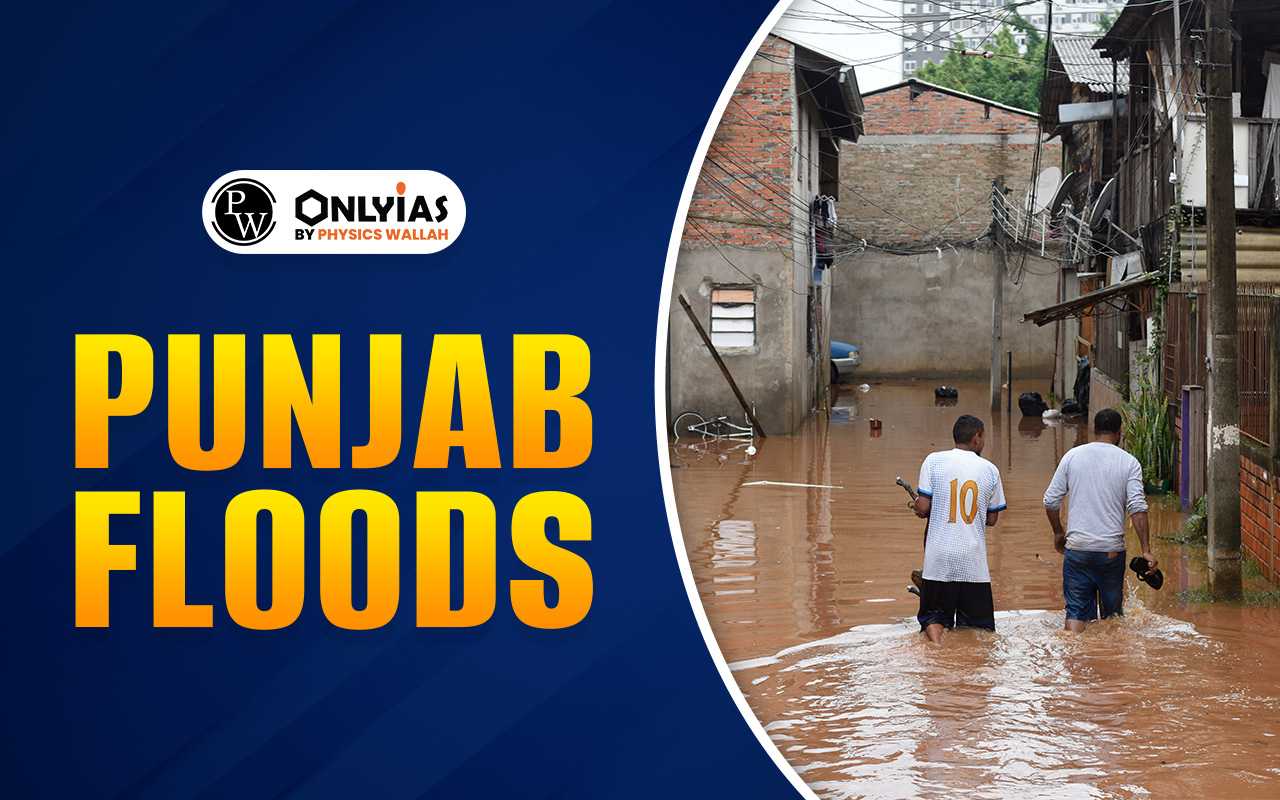Punjab Floods 2025 affected over 1,018 villages and 61,000 hectares of farmland. Punjab Floods highlight causes, river geography, doabs, impacts, and flood management strategies in India.

Punjab Floods: In August 2025, Punjab endured one of the most severe flood crises in decades. Recent figures confirm that 1,018 villages were affected and over 61,000 hectares of farmland submerged, particularly across Gurdaspur, Kapurthala, Ferozepur, Pathankot, Fazilka, Amritsar, Tarn Taran, Hoshiarpur, and Sangrur districts.
Chief Minister Bhagwant Mann has appealed to Prime Minister Modi for urgent relief, requesting the release of ₹60,000 crore in pending central funds and a significant increase in farmer compensation.
In the recent Punjab flood news, it has highlighted the submergence of vast agricultural lands, particularly in the Doaba region, which has caused extensive damage to standing crops.
The Indian Air Force and National Disaster Response Force (NDRF) were deployed for rescue operations. They have evacuated thousands of residents from submerged areas. Relief camps were also set up across the state to provide shelter, food, and medical assistance to the affected populations.
Punjab floods 2025 resulted from a combination of intense monsoon rains, overflowing rivers, and human-induced factors. All these elements led to widespread devastation across the region. Below, we’ve mentioned some of the reasons that led to the Punjab Floods:
Punjab is historically recognized for the Five Rivers of Punjab: Beas, Ravi, Sutlej, Chenab, and Jhelum. These rivers form the backbone of the state’s agricultural economy, providing irrigation and supporting livelihoods.
However, their extensive network also makes the region vulnerable to flooding. During periods of heavy rainfall, the water from these rivers can rise rapidly, leading to breaches and overflow into populated areas.
The Five Rivers of Punjab map shows how the rivers join with their smaller branches. It also shows the places that can get flooded easily. Having the right map helps people get ready and stay safe.
Punjab is divided into five main doabs. A doab is a piece of land that lies between two rivers. These five doabs in Punjab are:
| Doab Name | Location / Between Rivers |
| Bist Doab | Located between Beas and Sutlej rivers |
| Bari Doab | Between Ravi and Beas rivers |
| Rechna Doab | Between Chenab and Ravi rivers |
| Jech Doab | Between Jhelum and Chenab rivers |
| Sindh Sagar Doab | Between Jhelum and Indus rivers |
The doabs have always been important for farming. They lie close to rivers, which makes them more likely to face floods. Knowing the land structure of these doabs is helpful for quick flood relief work and for planning safety measures for the future.
Flood management combines and starts with infrastructure, early warning systems, and community preparedness. By following these steps, a proper flood management plan can be created. Below, we’ve mentioned some of the measures for flood Management in Punjab and India:
| Flood Management in Punjab and India | |
| Management Strategy | Explanation |
| Dam Management | Authorities monitor and regulate dam water releases. Controlled discharge prevents sudden downstream flooding. |
| River Channel Maintenance | Regular desilting and reinforcement of riverbanks improve flow capacity. This reduces the chance of river overflow. |
| Urban Drainage Improvement | Cities upgrade drainage systems to handle heavy rainfall. Proper water channels reduce urban waterlogging. |
| Community Awareness Programs | Citizens receive training about flood risks and safety measures. Awareness improves response during emergencies. |
| Disaster Response Coordination | State and national agencies work together during floods. Quick coordination ensures effective rescue and relief. |
The 2025 Punjab floods have brought many major disruptions in many fields. Starting from agriculture, infrastructure, to livelihoods, and many more. During this flood, there are lots of residents who were displaced, highlighting the disruption caused by to flood. Below, we’ve mentioned some of the aspects that were highly impacted by the Punjab floods:
| Impact of Punjab Floods | |
| Impact Category | Explanation |
| Agricultural Damage | Over 300,000 acres of farmland were submerged. Crops such as wheat and rice suffered extensive losses. |
| Infrastructure Destruction | Roads, bridges, and irrigation channels were damaged. Connectivity between towns and villages was disrupted. |
| Displacement | Thousands of people were evacuated to safer locations. Temporary relief camps were established to provide food and shelter. |
| Livestock Losses | Many animals drowned or were lost during displacement. Farmers faced economic and livelihood setbacks. |
| Economic Setback | Floods caused significant financial losses for the state. Both agriculture and infrastructure sectors were severely affected. |
Ready to boost your UPSC 2026 preparation? Join PW’s UPSC online courses today!
Heavy rainfall and river overflow were the primary causes.
Regions near the five rivers and low-lying doabs are most vulnerable.
Beas, Ravi, Sutlej, Chenab, and Jhelum.
Bist Doab, Bari Doab, Rechna Doab, Jech Doab, and Sindh Sagar Doab.
Through dams, embankments, early warning systems, and disaster management programs.

<div class="new-fform">
</div>